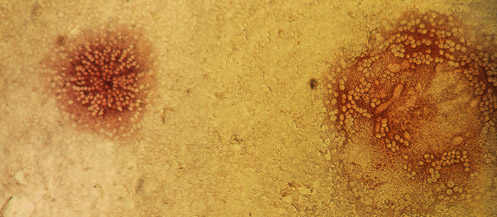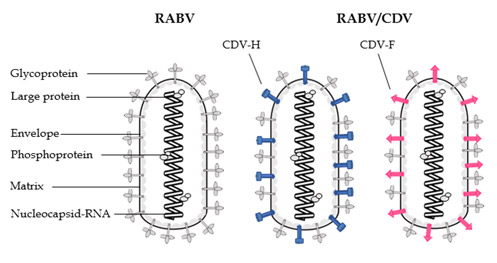Inactivated rabies viruses carrying canine distemper glycoproteins protect against both pathogens
Currently licensed live attenuated canine distemper vaccines are highly effective. However, they retain the potential to cause disease in very susceptible species. Researchers at Paul-Ehrlich-Institut and Thomas Jefferson University have generated an inactivated candidate vaccine that induces protective immunity against both rabies and canine distemper and has an excellent safety profile. The candidate vaccine consists of a mix of two recombinant inactivated rabies viruses that carry either one of the two canine distemper glycoproteins in addition to its own glycoprotein.The results are published in the online edition of Journal of Virology 1 February 2017.
Rabies and canine distemper are among the most dangerous and lethal viral diseases afflicting carnivores. Rabies can also be transmitted to humans via bite from rabies-infected animals. It attacks the nervous system and can be deadly if not treated immediately. Rabies vaccines contain inactivated virus particles and have an excellent stability and safety profile. For vaccination against canine distemper virus, which causes a measles-like disease in its hosts, live-attenuated viruses are used. These vaccine viruses replicate in the vaccinated animals to a certain extent and can lead to severe disease in highly susceptible species.
Prof. Dr. Veronika von Messling's group at the Veterinary Medicine Division, Paul-Ehrlich-Institut, in collaboration with Dr. Matthias Schnell's group at Thomas Jefferson University genetically engineered the rabies virus vaccine strain to carry one of the canine distemper virus glycoproteins in addition to its own glycoprotein. The protective immune response is directed against these proteins. Candidate vaccines were then produced following the purification and inactivation protocols used for rabies vaccines.
 Cells infected with canine distemper virus fuse to neighboring uninfected cells to form syncytia. Antibodies against canine distemper virus are used to stain the infected cells with a red dye
Source: PEI
Cells infected with canine distemper virus fuse to neighboring uninfected cells to form syncytia. Antibodies against canine distemper virus are used to stain the infected cells with a red dye
Source: PEI
 Cells infected with rabies virus were stained with antibodies from rabies-immunized animals. These cells can be seen by stimulating a fluorescent dye attached to the antibodies, which glows green.
Source: PEI
Cells infected with rabies virus were stained with antibodies from rabies-immunized animals. These cells can be seen by stimulating a fluorescent dye attached to the antibodies, which glows green.
Source: PEI
The researchers first demonstrated that a single shot was sufficient to elicit protective rabies antibody titers in ferrets. However, protection against canine distemper was only achieved when animals were immunized with a mix of viruses carrying both canine distemper virus glycoproteins. The researchers conclude that immune responses against both glycoproteins are necessary to protect from canine distemper.
"Our rabies-based vector is a promising platform for the development of new morbillivirus vaccines"
explains von Messling. "It eliminates the risk for vaccine-induced disease and at the same time greatly increases the temperature stability compared to live-attenuated morbillivirus vaccines."
 Rabies virus (left) was genetically modified to carry either the canine distemper virus H protein (middle, shown in blue) or F protein (right, shown in pink) on its surface.
Source: PEI
Rabies virus (left) was genetically modified to carry either the canine distemper virus H protein (middle, shown in blue) or F protein (right, shown in pink) on its surface.
Source: PEI
Original Publication
Da Fontoura Budaszewski R, Hudacek A, Sawatsky B, Krämer B, Xiangping Y, Schnell MJ, von Messling V (2017): Inactivated Recombinant Rabies Viruses Displaying Canine Distemper Virus Glycoproteins Induce Protective Immunity Against Both Pathogens.
J Virol 91: e02077-16.
Online-Abstract
Press Contact:
Paul-Ehrlich-Institut
Press Office
Dr. Susanne Stöcker, Dr. Corinna Volz-Zang, Brigitte Morgenroth
Paul-Ehrlich-Straße 51-59
63225 Langen
GERMANY
Telefon: +49 6103 77 1030
Telefax: +49 6103 77 1262
Email: presse@pei.de
The Paul-Ehrlich-Institut, the Federal Institute for Vaccines and Biomedicines, in Langen near Frankfurt/Main is a senior federal authority reporting to the Federal Ministry of Health (Bundesministerium für Gesundheit, BMG). It is responsible for the research, assessment, and marketing authorisation of biomedicines for human use and immunological veterinary medicinal products. Its remit also includes the authorisation of clinical trials and pharmacovigilance, i.e. recording and evaluation of potential adverse effects.
Other duties of the institute include official batch control, scientific advice and inspections. In-house experimental research in the field of biomedicines and life science form an indispensable basis for the manifold tasks performed at the institute.
The Paul-Ehrlich-Institut, with its roughly 800 members of staff, also has advisory functions nationally (federal government, federal states (Länder)), and internationally (World Health Organisation, European Medicines Agency, European Commission, Council of Europe etc.).
top





